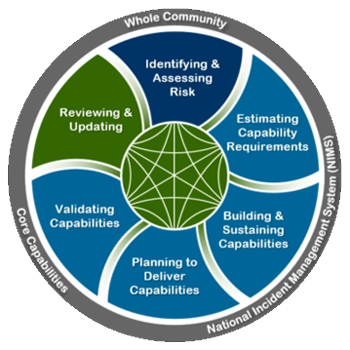About the National Incident Management System (NIMS)
The National Incident Management System was created by the U.S. Department of Homeland Security and is used by the Federal Emergency Management Agency (FEMA) to guide all levels of government, nongovernmental organizations and the private sector to work together to prevent, protect against, mitigate, respond to and recover from disasters or emergencies.
NIMS provides stakeholders across the whole community with the shared vocabulary, systems and processes to successfully deliver the capabilities described in the National Preparedness System (NPS). NIMS defines operational systems that guide how personnel work together during incidents.

National Preparedness System: Planning, Training and Exercise Working Together

Reviewing and Updating
- Evaluation results (including After Action Reports) drive the continuous improvement process cycle, updates to plans, the Integrated Preparedness Plan (IPP), Hazard Identification and Risk Assessment (HIRA), Threat and Hazard Identification and Risk Assessment (THIRA) and Stakeholder Preparedness Review (SPR), National Incident Management System (NIMS) and community lifelines.
Identifying and Assessing Risk
- Hazard Identification and Risk Assessment (HIRA): Quantitative assessment that identifies greatest hazards and threats
- Threat and Hazard Identification and Risk Assessment (THIRA): Lists greatest threats and hazards from HIRA, gives context, describes impact and impact data, establishes capability targets based on the NPS mission areas and core capabilities
Estimating Capability Requirements
- Stakeholder Preparedness Review (SPR): Assesses current capabilities, identifies capability gaps and approaches to address gaps, assesses impact of relevant funding sources on capabilities
- National Incident Management System (NIMS): Framework for incident management processes, protocols and procedures
Building and Sustaining Capabilities
- Prioritize investments in areas that address identified gaps and sustainment needs
Planning to Deliver Capabilities
- Develop and update plans per the Comprehensive Preparedness Guide (CPG) 101 (including IPP and mitigation plans) based on assessment results, capability targets, gaps, NIMS and inclusion of community lifelines
Validating Capabilities
NIMS and ICS Training
Online courses in the 100, 200, 700 and 800 series are the FEMA independent study (IS) courses to take to be considered trained on NIMS.
Please contact the Independent Study Program Office – Emergency Management Institute (EMI) at 301-447-1200 or independent.study@fema.dhs.gov for questions regarding the following:
- IS course certificates
- Re-issue IS course certificate
- Student transcripts
Independent Study Program Office hours are 7:30 a.m. to 7:30 p.m. ET Mondays through Fridays, except federal holidays.
